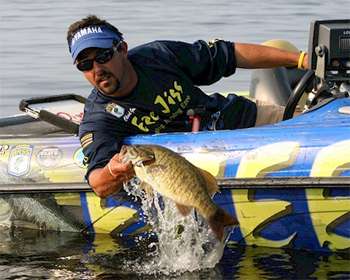
When Chad Griffin seemingly came from nowhere to claim his first Elite Series victory on New York's Oneida Lake, many fans wondered how a rookie could topple the biggest names in the sport on a body of water he had never seen before. Even though he was over 1,500 miles from his home waters in Texas, Griffin felt right at home flipping a jig and casting topwaters across Oneida's submerged grass. Here's how the Texas pro approaches, analyzes and catches bass from large grass flats.
"Basically, I'll start on the end of the grass, drop the trolling motor and take off down the edge of the grassline," says Griffin. "That's what I normally start doing every single time I fish grass." While this may seem like a freewheeling approach to finding bass hunkered down in a massive grass flat, there's a method to the Texan's madness.
It all comes down to focusing on the edges of the grassline. When approaching a grassy flat for the first time, he will usually start flipping or casting along the outside edge of the grassbed. The strategy often pays off with quality bass.
"Most of the time when I catch my larger bass, they're located on the outside edge of the grass," explains Griffin.
If he is unable to find the bass on the outside edge, Griffin then begins fishing the heart of the grassbed and eventually moves to the inside edge, closest to shore.
"If they're not in the grass, then they'll be on the inside edge of the grass," he says. "Most of the time with milfoil and other types of grass, there will be a bare spot between the bank and the edge of the grassline. That's what I call the inside edge. The bass will be on that edge, roaming around."
During the heat of the summer, the bass will most likely be concentrated along the deeper, outside edge of the grass or buried in the middle of the grass mat. But in fall, the inside grassline can be the ticket.
"During the fall, I concentrate on the inside edge of the grass right next to the bald spot between the grass and bank," he says.
On an average late summer day in Texas, Griffin has noticed that the bass have a tendency to utilize different parts of the grassbed depending on the time of day. Early in the morning, he might find them on the inside edge, while during the middle of the day, he might have to flip the thick grass or focus on the deeper outside edge.
When targeting massive quantities of grass, Griffin says that he takes a "flip until you get bit," approach. Once he has gets his first strike, the learning process begins."Each bite in a grass flat will tell you a story," he claims. "Fish are really primitive. They'll actually tell you what to do if you listen to them. Often, I'll look at my graph and notice something unique like an underwater point or drain where the bass was sitting. From there, I can start looking for similar features and create a pattern."
When assembling his tackle for fishing grass flats, Griffin will have six rods ready for action: two topwater rods rigged with a Zell Pop and XCalibur Jimmy; two Texas rigged flipping rods, one with a 3/4-ounce weight and the other with a 1-ounce weight pegged ahead of a Reaction Innovations Sweet Beaver; and two jig rods rigged with a 1-ounce and 1 1/4-ounce Ezee Grass Jig. With this simple arsenal, Griffin is able to target active bass, bass sitting on the grass edges and bass buried in the grass.




